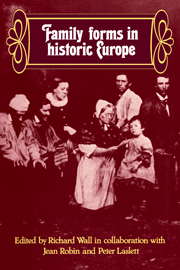Book contents
- Frontmatter
- Contents
- List of contributors
- Preface
- 1 Introduction
- 2 Two kinds of pre-industrial household formation system
- 3 ‘A large family: the peasant's greatest wealth’: serf households in Mishino, Russia, 1814–1858
- 4 The peasant family as an economic unit in the Polish feudal economy of the eighteenth century
- 5 The familial contexts of early childhood in Baltic serf society
- 6 Estonian households in the seventeenth and eighteenth centuries
- 7 Family and familia in early-medieval Bavaria
- 8 The property and kin relationships of retired farmers in northern and central Europe
- 9 Pre-industrial household structure in Hungary
- 10 The reconstruction of the family life course: theoretical problems and empirical results
- 11 The changing household: Austrian household structure from the seventeenth to the early twentieth century
- 12 Does owning real property influence the form of the household? An example from rural West Flanders
- 13 The evolving household: the case of Lampernisse, West Flanders
- 14 The composition of households in a population of 6 men to 10 women: south-east Bruges in 1814
- 15 The importance of women in an urban environment: the example of the Rheims household at the beginning of the Industrial Revolution
- 16 The household: demographic and economic change in England, 1650–1970
- 17 Family and household as work group and kin group: areas of traditional Europe compared
- References
- Index
6 - Estonian households in the seventeenth and eighteenth centuries
Published online by Cambridge University Press: 05 November 2011
- Frontmatter
- Contents
- List of contributors
- Preface
- 1 Introduction
- 2 Two kinds of pre-industrial household formation system
- 3 ‘A large family: the peasant's greatest wealth’: serf households in Mishino, Russia, 1814–1858
- 4 The peasant family as an economic unit in the Polish feudal economy of the eighteenth century
- 5 The familial contexts of early childhood in Baltic serf society
- 6 Estonian households in the seventeenth and eighteenth centuries
- 7 Family and familia in early-medieval Bavaria
- 8 The property and kin relationships of retired farmers in northern and central Europe
- 9 Pre-industrial household structure in Hungary
- 10 The reconstruction of the family life course: theoretical problems and empirical results
- 11 The changing household: Austrian household structure from the seventeenth to the early twentieth century
- 12 Does owning real property influence the form of the household? An example from rural West Flanders
- 13 The evolving household: the case of Lampernisse, West Flanders
- 14 The composition of households in a population of 6 men to 10 women: south-east Bruges in 1814
- 15 The importance of women in an urban environment: the example of the Rheims household at the beginning of the Industrial Revolution
- 16 The household: demographic and economic change in England, 1650–1970
- 17 Family and household as work group and kin group: areas of traditional Europe compared
- References
- Index
Summary
During recent years considerable progress has been made in the study of household structure in the U.S.S.R., especially in Estonia. Several studies have been published on the structure of Estonian households, and more are to appear in the near future.
Estonian households are on the whole more complex than those in western Europe. Households with farmhands, whether male or female, are very common, and some even contain the families of such farm servants. On the south Estonian mainland during the seventeenth and eighteenth centuries, complicated houseful systems existed, with two or more farmers' households on one farm (poolemaamehed in Estonian, Hälftner in German, but here we call them ‘co-farmers’). In these circumstances Peter Laslett's standard classificatory table on the typology of households cannot be applied without some slight changes. However, a full picture of Estonian households in those days can be given if we allocate the categories and classes of this table to smaller groups: households without farmhands; households where the farmhands are unmarried or without their families; and households containing farmhands together with their families. For south Estonia four categories have to be distinguished: one household to a farm; one farmer's household together with one or more cotters' households to a farm; the households of co-farmers on a single farm; and the households of co-farmers together with cotter(s)' households on a single farm (see table 6.5 below).
- Type
- Chapter
- Information
- Family Forms in Historic Europe , pp. 207 - 216Publisher: Cambridge University PressPrint publication year: 1983
- 7
- Cited by



